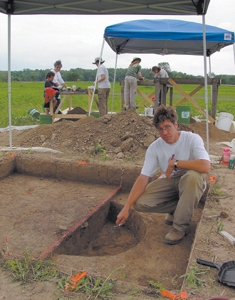ARCHAEOLOGICAL DIG CONTINUES NEAR ABOITE

Andrew White, Assistant Director of the IPFW Archaeological Survey, was in charge, and he took the time to show me around. The area being studied was purchased by the LRWP and was originally the Buell property. Because the wetlands restoration project was funded by a government grant, they were required to do an archeological survey before disturbing the ground.
This area was part of the Wabash Sluiceway, the channel created when Lake Maumee drained into the Wabash Valley about 14,000 years ago. The site itself is a small rise within the sluiceway. The rise was a natural area for Native Americans to camp as it is near the water, yet, high enough in elevation to keep the campsite dry most of the year. IPFW’s Archaeological Director, Andrew, feels this area had been used and reused as a campsite over thousands of years. Because the area floods frequently, there may have been sediments deposited over the years, possibly preserving the earliest remains below the reach of the plow.
Before excavation archaeologists from IPFW systematically walked the area, marked the locations of prehistoric artifacts, and plotted their locations to create a map of the surface of the site. The area containing the highest concentration of artifacts is the area that he focuses on as the most likely place for good deposits below the plowzone. He then scans the area with a magnetometer, which is an instrument that measures abnormalities in the magnetic field, near the surface of the earth. After the magnetometer data is collected it is printed to a grid that is scaled in square meters. Andrew then places excavation units over areas of interest and the actual digging begins.
As dirt is taken out of the area it is manually forced through a screen. The artifacts remaining after the dirt has been removed, are then taken to the lab, cleaned, and cataloged. Some of the charcoal remains found in a fire pit area may be sent out for carbon dating. Soil from the pit will be processed to remove tiny burned seeds and artifacts so small they might go through the screen. Andrew is looking for dates ranging back to 10,000-12,000 years Before Present (BP), which would be about the time the first people might have entered this area.
The work seemed tedious and difficult yet it was going along smoothly. Andrew said, “We know very little about the people that inhabited this area so long before we got here. The hard work is all worth it when you gain some insight into the cultures of those that lived here thousands of years ago.”
Andrew is interested in examining and documenting collections of prehistoric artifacts from the local area, particularly those that have been personally collected by the owners. He is most interested in Paleoindian artifacts such as fluted spearpoints. Interested members of the public are encouraged to visit the IPFW Archaeological Survey webpage:
www.ipfw.edu/ or contact him directly by phone (260-481-6194) or email (whitea@ipfw.edu).
Please look through your collection!
If you have Paleoindian artifacts from the area or think you may have Paleoindian artifacts, contact Andy White at the IPFW Archaeological Survey: (260) 481-6194.
- What To Know About Mosquito Season - July 19, 2024
- Local Worship & Events: July 19 Update - July 19, 2024
- Allen County Bar Foundation Announces Scholarship Winners - July 19, 2024


